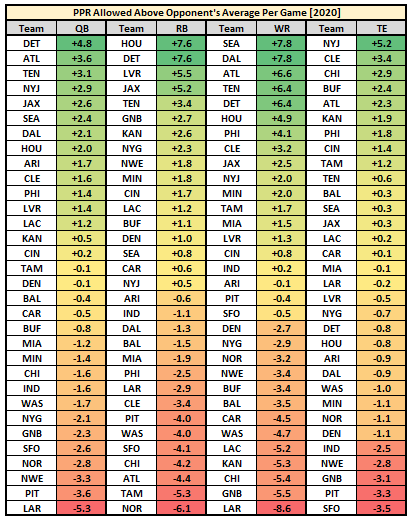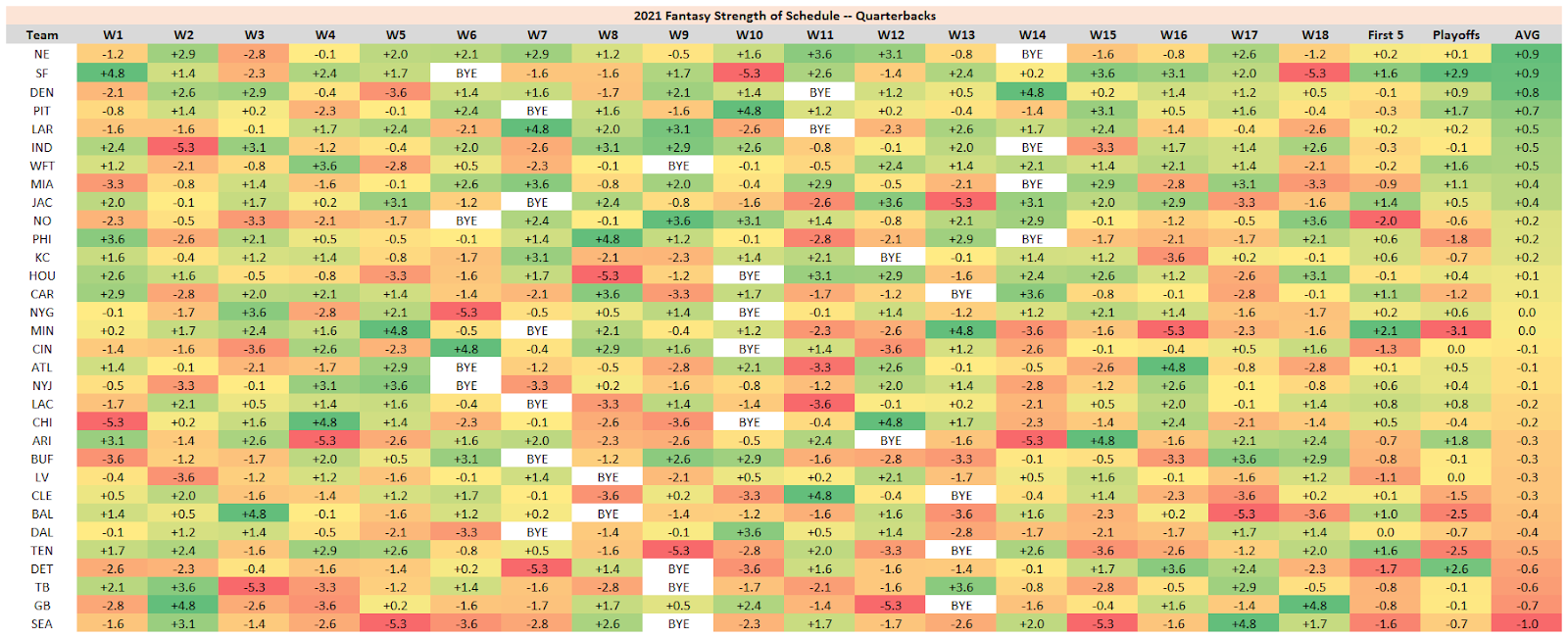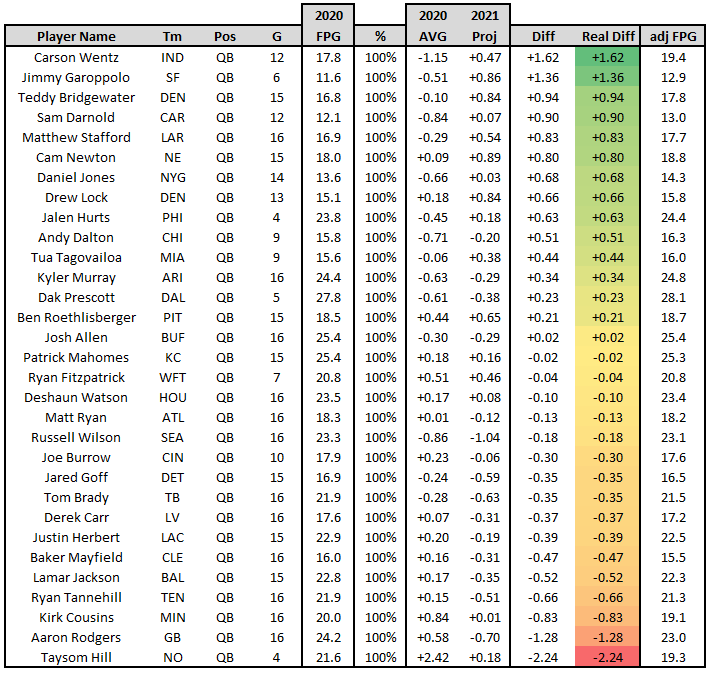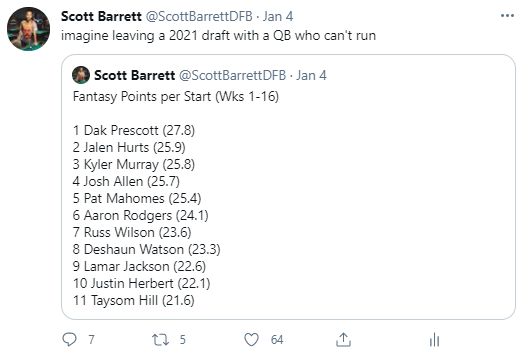Other Positions: Running Backs Wide Receivers Tight Ends
Never Bury the Lede: The difference between Carson Wentz’s schedule last year and his schedule this year was the difference between him finishing 23rd and 16th in fantasy points per game started.
Which quarterbacks have the toughest or easiest fantasy schedules this year? Which quarterbacks had the toughest or easiest schedules last year? Or, what about the toughest or easiest schedules in the fantasy postseason this year? Or to start the season? Which quarterbacks saw their schedules improve the most or least? How big of an impact was that change in schedule? Can we quantify that change in real terms using fantasy points?
Luckily for our subscribers, we can answer all of these questions and more. But in order to do so, we first had to quantify strength of schedule (SOS). This is typically done by calculating a defense’s FPG allowed average, and then looking at the average for all players over a full season. This will also be our approach; however, we’ll be taking things one step further – we’re going to use a control for the opposing offense by measuring FPG over an opponent’s average.
For instance, last season, opposing quarterbacks averaged +4.8 fantasy points per game over their season-long average when facing Detroit, which ranked worst in the league. (Detroit was the most favorable fantasy matchup for opposing quarterbacks — worth, on average, an additional 4.8 fantasy points per game.) On the opposite end of the spectrum, quarterbacks fell short of their season-long average by 5.3 points when facing the Rams, which ranked best in the league. (The Rams were the toughest fantasy matchup for opposing quarterbacks.)
Ah then, you might ask, do defenses get the benefit of being “tough” matchups because bad QB play against them is dragging the numbers down? Not for this study. The SOS average used in this study controls for quality of opponent by eliminating a QB’s own performance against a defense when measuring that individual’s SOS. So this SOS study filters out the notion that the quarterback being studied was responsible for his own schedule difficulty — I measure the QB’s SOS by measuring how his peers performed relative to their average against a particular defense. In essence, the defenses playing Carson Wentz don’t simply look tough statistically because they were playing Carson Wentz during a bad season, because I control for that. Wentz still performed worse against tough defenses than “easy” defenses.
Calculating these numbers for all teams and then applying the full-season average for all players quantifies in real terms which players had the easiest and most difficult schedules for fantasy last year. We can also use these numbers to project out strength of schedule for each team and each position in 2021.
While this methodology isn’t perfect — of course roster turnover and coaching changes will complicate things — strength of schedule doesn’t not matter. This data is still far more actionable than it is not. In fantasy football — like in poker — there may only be small edges to be gained, but those small edges can be compounded to yield a massive advantage. And they must be taken advantage of … and are, by the most dominant players. That’s the case with strength of schedule. It’s another small edge to be realized, and at the polar extremes, it might matter a lot more than you’d expect.
Here’s an example: last season, Carson Wentz had the toughest schedule among all fantasy quarterbacks. His average matchup was worth -1.15 [team quarterback] FPG. Because he was responsible for just about 100% of the fantasy points generated by Philadelphia’s quarterbacks last year (in games he started), we can say that – adjusted for strength of schedule, or if he had a perfectly average strength of schedule last year – he would have scored an additional +1.15 fantasy points per start. This would have been the difference between him finishing 23rd in fantasy points per start (17.8) and 17th (18.9). Looking forward, Wentz’s schedule is much-improved (most-improved at the position), fairly soft (6th-softest), and worth an additional +0.47 fantasy points per game in real terms. Essentially, if he had this schedule last year, he should have scored 19.4 fantasy points per start, which would have ranked 16th-best.
Clearly, strength of schedule – something totally outside of a player’s control and entirely due to luck – can have a big impact for fantasy.
Best Overall Schedule (2020)
1. Taysom Hill, Average Matchup: +2.42
2. Philip Rivers (+1.12)
3. Gardner Minshew (+1.07)
4. Kirk Cousins (+0.84)
5. Aaron Rodgers (+0.58)
Worst Overall Schedule (2020)
1. Carson Wentz (-1.15)
2. Russell Wilson (-0.86)
3. Sam Darnold (-0.84)
4. Andy Dalton (-0.71)
5. Daniel Jones (-0.66)
2021 Schedule
PDF Download available here.
CSV Download available here.
Best Overall Schedule (Weeks 1-17)
1. Cam Newton/Mac Jones (+0.89)
2. Jimmy Garoppolo/Trey Lance (+0.86)
3. Drew Lock/Teddy Bridgewater (+0.84)
4. Ben Roethlisberger (+0.65)
5. Matthew Stafford (+0.54)
Worst Overall Schedule (Weeks 1-17)
1. Russell Wilson (-1.04)
2. Aaron Rodgers/Jordan Love (-0.70)
3. Tom Brady (-0.63)
4. Jared Goff (-0.59)
5. Ryan Tannehill (-0.51)
Off to a Hot Start (First Five Weeks)
1. Kirk Cousins (+2.14)
t2. Ryan Tannehill (+1.60)
t2. Jimmy Garoppolo/Trey Lance (+1.60)
4. Trevor Lawrence (+1.38)
5. Sam Darnold (+1.12)
Slow Starters (First Five Weeks)
1. Jameis Winston/Taysom Hill (-1.98)
2. Jared Goff (-1.66)
3. Russell Wilson (-1.56)
4. Joe Burrow/Brandon Allen (-1.26)
5. Derek Carr (-1.12)
Best Playoff Schedule (Weeks 15-17)
1. Jimmy Garoppolo/Trey Lance (+2.90)
2. Jared Goff (+2.57)
3. Kyler Murray (+1.77)
4. Ben Roethlisberger (+1.73)
5. Ryan Fitzpatrick (+1.63)
Worst Playoff Schedule (Weeks 15-17)
1. Kirk Cousins (-3.07)
t2. Ryan Tannehill (-2.47)
t2. Lamar Jackson (-2.47)
4. Jalen Hurts (-1.83)
5. Baker Mayfield (-1.50)
Schedule Change (In Real Points)
Most Improved Schedule
1. Carson Wentz (+1.62)
2. Jimmy Garoppolo (+1.36)
3. Teddy Bridgewater (+0.94)
4. Sam Darnold (+0.90)
5. Matthew Stafford (+0.83)
Least Improved Schedule
1. Taysom Hill (-2.24)
2. Aaron Rodgers (-1.28)
3. Kirk Cousins (-0.83)
4. Ryan Tannehill (-0.66)
5. Lamar Jackson (-0.52)
Thoughts/Notes/Dank Stats
- No quarterback will benefit more from an improved schedule this year than Carson Wentz. (Explained in more detail in the introduction.)
- In Superflex leagues, New Orleans’ QB2 is certainly worth stashing as a handcuff. They have by far the toughest schedule over the first five weeks of the season (-1.98). So, even if Jameis Winston is named the starter, don’t be surprised if Taysom Hill takes over after a rough and turnover-filled start to the season. But, that being said, Hill also benefited from the easiest strength of schedule last season, worth an additional +2.42 FPG to his per-game average across his four starts. Without that, he would have fallen from 11th (21.6) to 17th (19.2) in fantasy points per start average.
- Kirk Cousins is an ideal target for QB-streamers. He has by far the softest schedule over the first five weeks of the season (+2.14). That said, Cousins’ overall schedule isn’t great and ranks third least-improved (-0.83) among all QBs.
- Tom Brady was the most matchup-sensitive QB for fantasy last season (+/-9.0), averaging 26.2 FPG in matchups ranking better than average (seven such games) and only 17.2 FPG in matchups ranking tougher than average (nine such games). Unfortunately for him, his schedule is a bit tougher this season (-0.35) and ranks third-toughest overall.
- Ryan Tannehill was similarly matchup-sensitive (+/-7.4), averaging 25.2 FPG in matchups ranking better than average (eight such games) and only 17.8 FPG in matchups ranking tougher than average (eight such games). Tannehill’s schedule will be quite a bit tougher this season (-0.66) and ranks fifth-toughest overall.
- One more reason for Aaron Rodgers to think about leaving Green Bay? He has the second-worst projected change in schedule this season (-1.28), going from the fifth-easiest schedule to second-toughest this year.
- San Francisco’s playoff schedule is far and away the best for any team (+2.90). That bodes extremely well for Trey Lance, who I have a hard time imagining isn’t the team’s full-time starter by at least mid-season. And who I have a hard time imagining doesn’t put up top-12 numbers on a per-start-basis. First off, Lance has massive Konami Code-upside. He averaged 13.3 rushing FPG over his last two seasons at North Dakota State — that was significantly more than any other rookie QB, and was also more than what Kyler Murray put up in his Heisman season at Oklahoma (12.8 rushing FPG). Second, he landed in a dream scenario, coached by Kyle Shanahan and surrounded with an elite receiving corps. Since 2018, Russell Wilson averages 7.8 yards per pass attempt. That’s less than both Nick Mullens (7.9) and Jimmy Garoppolo (8.2, behind only Deshaun Watson and Patrick Mahomes) over the same span. Brandon Aiyuk averaged 9.9 yards after the catch per reception during his career at Arizona State. That ranks best by any Power-5 WR since at least 2014. Deebo Samuel leads all WRs by the same stat since entering the NFL (9.8). And George Kittle leads all TEs since entering the NFL (7.9). Essentially, Lance is so well set up that he could average a 7.8 YPA on a 4.3 aDOT. Add in the rushing floor and he has legitimate league-winning upside.
- Moving from New York to Carolina, Sam Darnold’s schedule is significantly improved this season (+0.90), worth in real terms a boost from 12.1 FPG to 13.0. If also adjusting for the improved supporting cast — Jamison Crowder, Breshad Perriman, and Braxton Berrios (New York’s three most-targeted receivers last season) to D.J. Moore, Robby Anderson, and Terrace Marshall — we can give him another boost of about 3.1 FPG. If further adjusting for the offensive play-caller change — Adam Gase to Joe Brady — we can add another 37.6 FPG to his 2020 average, giving him an adjusted FPG average of 53.7. Of course, I’m joking here, but I am very bullish on the 23-year-old Darnold relative to current ADP (QB28).
- Similarly, Matthew Stafford is one of my favorite QB targets this year (probably my second-favorite QB target, just behind Jalen Hurts) who has a much-improved schedule (+0.83) in addition to a much-improved supporting cast (including HC Sean McVay).
- On-paper Baker Mayfield’s 2020 schedule was fine: about average or slightly better than average (+0.16). But his schedule was both brutal and incredibly unlucky in a less obvious way. A whopping five of his 16 games came with winds measuring between 16 and 35 mph. If only excluding the two games where winds were measured between 25 to 35 mph, his FPG average jumps from 16.0 to 17.4 (+1.4).












